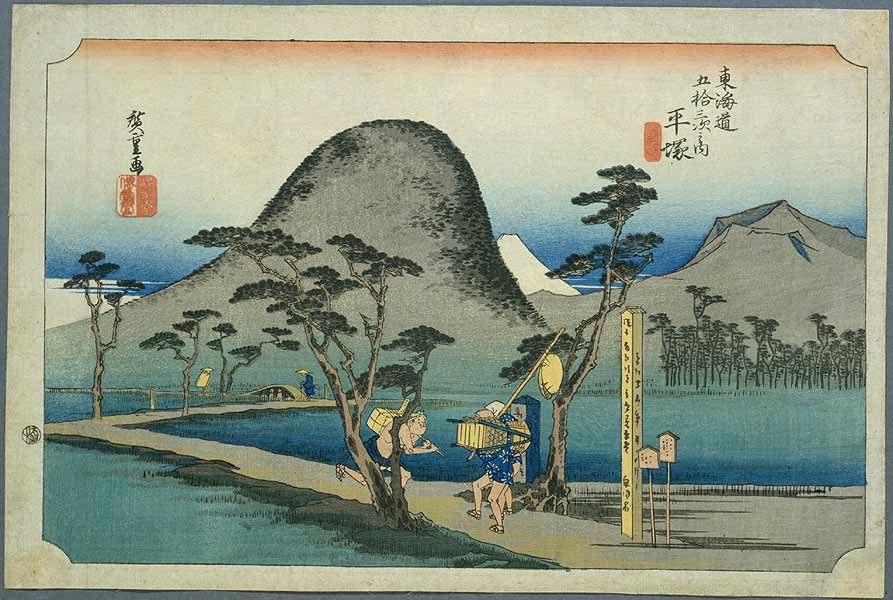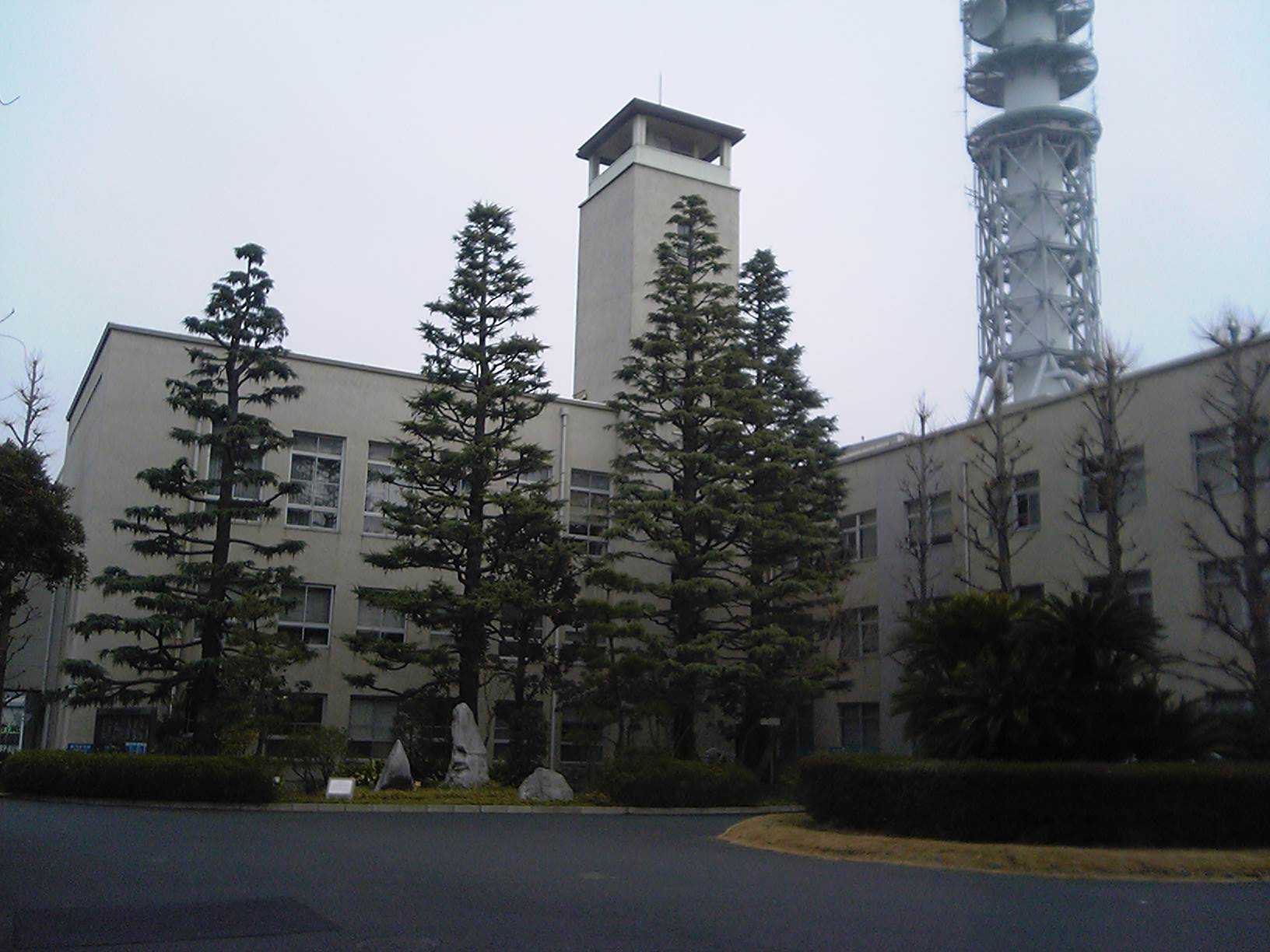|
Fujisawa-shuku
was the sixth of the fifty-three stations of the Tōkaidō. It is located in the present-day city of Fujisawa, Kanagawa Prefecture, Japan. History Fujisawa-shuku was established as a post station on the Tōkaidō in 1601, but did not become the sixth post station until Totsuka-juku was later established. Before the establishment of the Tōkaidō, Fujisawa flourished as a for Shōjōkō-ji, also known as " Yugyō-ji" (), the head temple of the Ji-sect of Japanese Buddhism. It was also located on a fork along the Odawara Kaidō, which connected Odawara Castle and its two supporting castles, Edo Castle and Hachiōji Castle during the period of the Late Hōjō clan. The toward Edo was to the east of Yugyō-ji, and the gate towards Kyoto was on the western side of the modern Odakyū Enoshima Line; these boundaries mark the general limits of Fujisawa-juku. It was said that there were over 1,000 buildings in the post town, including ''honjin'', ''hatago'', etc. [...More Info...] [...Related Items...] OR: [Wikipedia] [Google] [Baidu] |
Hiratsuka-juku
was the seventh of the fifty-three stations (''shukuba'') of the Tōkaidō. It is located in the present-day city of Hiratsuka, Kanagawa Prefecture, Japan. History Hiratsuka-juku was first established in 1601, at the orders of Tokugawa Ieyasu.11 Hiratsuka-juku Hiratsuka City Museum. Accessed November 5, 2007. In 1651, though, it merged with part of the nearby village of Yawata. In 1655, it was renamed "Shinhiratsuka-juku." During a in 1843, the post station was found to have a population of 2,114 people and 443 houses, which included one '''', 1 ... [...More Info...] [...Related Items...] OR: [Wikipedia] [Google] [Baidu] |
Totsuka-juku
was the fifth of the 53 Stations of the Tōkaidō, fifty-three stations (''shukuba'') of the Tōkaidō (road), Tōkaidō. It was the easternmost post station in Sagami Province. It is now located in Totsuka-ku, Yokohama, Totsuka-ku in the present-day city of Yokohama, Kanagawa, Yokohama, Kanagawa Prefecture, Japan. History Because Totsuka-juku was approximately one day's journey from Nihonbashi, it was a very common resting place for travelers at the start of the journey and the largest post station after Odawara-juku.Tōkaidō to Totsuka-juku Yokohama City Hall. Accessed December 10, 2007. Because of its size, there were two ''honjin'' in the post station as well, one belonging to the Sawabe family (澤辺) and the other belonging to the Uchida family (内田). Another reason for Totsuka-juku being so large wa ... [...More Info...] [...Related Items...] OR: [Wikipedia] [Google] [Baidu] |
53 Stations Of The Tōkaidō
The are the rest areas along the Tōkaidō, which was a coastal route that ran from Nihonbashi in Edo (modern-day Tokyo) to Sanjō Ōhashi in Kyoto.. There were originally 53 government post stations along the Tōkaidō, where travelers had to present traveling permits at each station if wanting to cross. In 1619, the Ōsaka Kaidō (大阪街道) was developed to extend the Tōkaidō so that it would reach Kōraibashi in modern-day Osaka. Instead of going to Sanjō Ōhashi, travelers would leave from Ōtsu-juku and travel towards Fushimi-juku. Because of the addition of these four post towns, the Tōkaidō is occasionally referred to as having 57 stations. Another name for this extension was Kyōkaidō (京街道). The inland Nakasendō also started at Nihonbashi, and converged with the Tōkaidō at Kusatsu-juku. Shio no Michi intersected with the Tōkaidō at Okazaki-shuku. Stations of the Tōkaidō See also * Edo Five Routes ** 69 Stations of the Nakase ... [...More Info...] [...Related Items...] OR: [Wikipedia] [Google] [Baidu] |
Fujisawa, Kanagawa
is a city in Kanagawa Prefecture, Japan. , the city had an estimated population of 439,728 and a population density of 6300 persons per km². The total area of the city is . Geography Fujisawa is in the central part of Kanagawa Prefecture. It faces Sagami Bay of the Pacific Ocean. The northern part of the city is on the Sagamino plateau while the southern part is on the Shonan Dunes. Fujisawa has three major topographical features: the island of Enoshima to the south connected to the Katase shoreline area by a road bridge, and two rivers, the Hikiji and the Sakai, which run north-south. The Hikiji can be traced from an area designated as a nature reserve park in the city of Yamato and flows directly along the boundary of the joint US Navy and Japan Maritime Self-Defense Force Atsugi Naval Air Base and the United States Army Camp Zama. The Sakai runs directly from the mountains between Machida and Hachiōji, and for quite some distance forms the border between the Tokyo Metr ... [...More Info...] [...Related Items...] OR: [Wikipedia] [Google] [Baidu] |
Torii
A is a traditional Japanese gate most commonly found at the entrance of or within a Shinto shrine, where it symbolically marks the transition from the mundane to the sacred. The presence of a ''torii'' at the entrance is usually the simplest way to identify Shinto shrines, and a small ''torii'' icon represents them on Japanese road maps. The first appearance of ''torii'' gates in Japan can be reliably pinpointed to at least the mid-Heian period; they are mentioned in a text written in 922. The oldest existing stone ''torii'' was built in the 12th century and belongs to a Hachiman shrine in Yamagata Prefecture. The oldest existing wooden ''torii'' is a ''ryōbu torii'' (see description below) at Kubō Hachiman Shrine in Yamanashi Prefecture built in 1535. ''Torii'' gates were traditionally made from wood or stone, but today they can be also made of reinforced concrete, copper, stainless steel or other materials. They are usually either unpainted or painted vermilion with a bl ... [...More Info...] [...Related Items...] OR: [Wikipedia] [Google] [Baidu] |
Andō Hiroshige
Utagawa Hiroshige (, also ; ja, 歌川 広重 ), born Andō Tokutarō (; 1797 – 12 October 1858), was a Japanese ''ukiyo-e'' artist, considered the last great master of that tradition. Hiroshige is best known for his horizontal-format landscape series ''The Fifty-three Stations of the Tōkaidō'' and for his vertical-format landscape series ''One Hundred Famous Views of Edo''. The subjects of his work were atypical of the ''ukiyo-e'' genre, whose typical focus was on beautiful women, popular actors, and other scenes of the urban pleasure districts of Japan's Edo period (1603–1868). The popular series '' Thirty-six Views of Mount Fuji'' by Hokusai was a strong influence on Hiroshige's choice of subject, though Hiroshige's approach was more poetic and ambient than Hokusai's bolder, more formal prints. Subtle use of color was essential in Hiroshige's prints, often printed with multiple impressions in the same area and with extensive use of '' bokashi'' (color gradation), ... [...More Info...] [...Related Items...] OR: [Wikipedia] [Google] [Baidu] |
Ukiyo-e
Ukiyo-e is a genre of Japanese art which flourished from the 17th through 19th centuries. Its artists produced woodblock prints and paintings Painting is the practice of applying paint, pigment, color or other medium to a solid surface (called the "matrix" or "support"). The medium is commonly applied to the base with a brush, but other implements, such as knives, sponges, and ai ... of such subjects as female beauties; kabuki actors and sumo wrestlers; scenes from history and folk tales; travel scenes and landscapes; Flora of Japan, flora and Wildlife of Japan#Fauna, fauna; and Shunga, erotica. The term translates as "picture[s] of the floating world". In 1603, the city of Edo (Tokyo) became the seat of the ruling Tokugawa shogunate. The ''chōnin'' class (merchants, craftsmen and workers), positioned at the bottom of Four occupations, the social order, benefited the most from the city's rapid economic growth, and began to indulge in and patronise the entertainment o ... [...More Info...] [...Related Items...] OR: [Wikipedia] [Google] [Baidu] |
Enoshima
is a small offshore island, about in circumference, at the mouth of the Katase River which flows into the Sagami Bay of Kanagawa Prefecture, Japan. Administratively, Enoshima is part of the mainland city of Fujisawa, and is linked to the Katase section of that city by a bridge. Home to some of the closest sandy beaches to Tokyo and Yokohama, the island and adjacent coastline are the hub of a local resort area. History Classical era Benzaiten, the goddess of music and entertainment, is enshrined on the island. The island in its entirety is dedicated to the goddess, who is said to have caused it to rise from the bottom of the sea in the sixth century. The island is the scene of the ''Enoshima Engi'', a history of shrines on Enoshima written by the Japanese Buddhist monk Kōkei in 1047 AD. Modern era In 1880, after the Shinto and Buddhism separation order of the new Meiji government had made the land available, much of the uplands was purchased by Samuel Cocking, a B ... [...More Info...] [...Related Items...] OR: [Wikipedia] [Google] [Baidu] |
Honjin
The ''honjin'' at Inaba Kaidō's Ōhara-shuku.">Ōhara-shuku.html" ;"title="Inaba Kaidō's Ōhara-shuku">Inaba Kaidō's Ōhara-shuku. is the Japanese word for an inn for government officials, generally located in post stations (''shukuba'') during the later part of the Edo period. Evolution of ''Honjin'' Originally, ''honjin'' were places from which generals directed battles and, therefore, were fleeting in nature. However, as commanders began to transform the ''honjin'' into temporary lodgings during battle and travel, ''honjin'' came to be places where ''daimyō'' and other representatives of the shogunate, including ''hatamoto'', ''monzeki'', etc., were allowed to stay during their travels. Many of the ''honjin'' were actually personal residences of village and town leaders. As such, they received official designations from the government and expanded their residences to include walls, gates and other features. Because of their cooperation, the owners of the ''honjin'' also ... [...More Info...] [...Related Items...] OR: [Wikipedia] [Google] [Baidu] |
Tokugawa Iemitsu
Tokugawa Iemitsu (徳川 家光, August 12, 1604 – June 8, 1651) was the third ''shōgun'' of the Tokugawa dynasty. He was the eldest son of Tokugawa Hidetada with Oeyo, and the grandson of Tokugawa Ieyasu. Lady Kasuga was his wet nurse, who acted as his political adviser and was at the forefront of shogunate negotiations with the Imperial court. Iemitsu ruled from 1623 to 1651; during this period he crucified Christians, expelled all Europeans from Japan and closed the borders of the country, a foreign politics policy that continued for over 200 years after its institution. It is debatable whether Iemitsu can be considered a kinslayer for making his younger brother Tadanaga commit suicide by seppuku. Early life (1604–1617) Tokugawa Iemitsu was born on 12 August 1604. He was the eldest son of Tokugawa Hidetada and grandson of the last great unifier of Japan, the first Tokugawa ''shōgun'' Tokugawa Ieyasu.Nussbaum, Louis-Frédéric. (2005). "''Tokugawa, Iemitsu''" in ; n.b ... [...More Info...] [...Related Items...] OR: [Wikipedia] [Google] [Baidu] |
Tokugawa Hidetada
was the second ''shōgun'' of the Tokugawa dynasty, who ruled from 1605 until his abdication in 1623. He was the third son of Tokugawa Ieyasu, the first ''shōgun'' of the Tokugawa shogunate. Early life (1579–1593) Tokugawa Hidetada was born to Tokugawa Ieyasu and the Lady Saigō on May 2, 1581. This was shortly before Lady Tsukiyama, Ieyasu's official wife, and their son Tokugawa Nobuyasu were executed on suspicion of plotting to assassinate Oda Nobunaga, who was Nobuyasu's father-in-law and Ieyasu's ally. By killing his wife and son, Ieyasu declared his loyalty to Nobunaga. In 1589, Hidetada's mother fell ill, her health rapidly deteriorated, and she died at Sunpu Castle. Later Hidetada with his brother, Matsudaira Tadayoshi, was raised by Lady Achaa, one of Ieyasu's concubines. His childhood name was , later becoming . The traditional power base of the Tokugawa clan was Mikawa. In 1590, the new ruler of Japan, Toyotomi Hideyoshi enlisted Tokugawa Ieyasu and others in ... [...More Info...] [...Related Items...] OR: [Wikipedia] [Google] [Baidu] |






_Awa_Naruto_no_fuukei.jpg)


